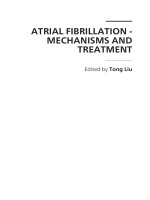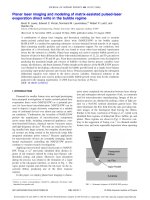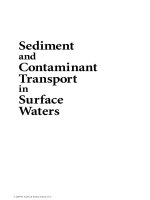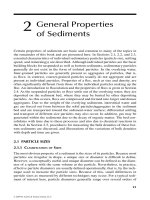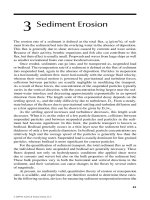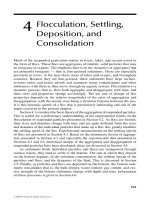Somatic coliphage PHIX174 inactivation kinetics, mechanisms and modeling in surface waters
Bạn đang xem bản rút gọn của tài liệu. Xem và tải ngay bản đầy đủ của tài liệu tại đây (1.37 MB, 181 trang )
1
SOMATIC COLIPHAGE PHIX174 INACTIVATION
KINETICS, MECHANISMS AND MODELING IN
SURFACE WATERS
-ROLE OF UVA/VISIBLE LIGHT, NOM, SALINITY AND
MICROALGAE
SUN CHENXI (B. Eng, NUS)
A THESIS SUBMITTED FOR THE DEGREE OF DOCTOR OF
PHILOSOPHY
DEPARTMENT OF CIVIL AND ENVIRONMENTAL ENGINEERING
NATIONAL UNIVERSITY OF SINGAPORE
08 Jan 2015
i
DECLARATION
I hereby declare that this thesis is my original work and it has been written by
me in its entirety. I have duly acknowledged all the sources of information
which have been used in the thesis.
This thesis has also not been submitted for any degree in any university
previously.”
Sun Chenxi
ii
Acknowledgements
I would like to express my special appreciation and thanks to my advisor
Professor Karina Gin Yew-Hoong, you have been a tremendous mentor for me.
I would like to thank you for encouraging my research and for allowing me to
grow as a researcher. Your advice on both research as well as life has been
invaluable.
Special thanks to my family. Words cannot express how grateful I am to my
parents and other family members for all of the sacrifices that you’ve made on
my behalf. I would also like to thank my dearest friends, Tang Fenglin, Jiang
Li, Peng Bo, Dr. Yeo Bee Hui, and etc. Thank all of you for supporting me for
everything, and especially I can’t thank you enough for your encouragement at
my difficult and depressed times.
I would also like to thank Dr. Masaaki Kitajima for the help on
microbiological experiment as well as Dr. Nguyen Viet Tung and Mr. Ling
Ran for the help on chemical experiment.
I thank all the members of the Gin-Lab as well as my office mates.
The past four years of PhD study has truly been a memorable experience and
will always be an important part of my life. I could not have done this without
all the help and caring that I received. Best wishes for all.
iii
TABLE OF CONTENTS
1 IINTRODUCTION 1
1.1 Background 1
1.2 Research Questions, Objective and Scope 4
2 LITERATURE REVIEW 7
2.1 Overview 7
2.2 Significance of enteric viruses and application of surrogate viruses in
microbial water quality management 7
2.3 Virus inactivation kinetics and mechanisms 9
2.4 Virus inactivation by sunlight 17
2.5 Effect of natural organic matter (NOM) on sunlight mediated virus
inactivation 23
2.6 Effect of salinity on virus inactivation by sunlight 25
2.7 Algae in water environment 30
2.8 Singapore surface water and knowledge gaps 30
2.8.1 Singapore surface water 30
2.8.2 Knowledge gaps 31
3 PHIX174 INACTIVATION BY LONG WAVELENGTHS SUNLIGHT
AND NOM 33
3.1 Abstract 33
3.2 Introduction 34
3.3 Methods 36
3.3.1 Coliphage and Host Bacteria Preparation 37
3.3.2 Coliphage Enumeration 38
3.3.3 Sunlight Inactivation Experiment 38
iv
3.3.4
Quencher Experiment and reactive oxygen species (ROS)
measurement 38
3.3.5 Effects of NOM 40
3.3.6 Data Analysis 40
3.3.7 Inactivation Model Description 40
3.4 Results 43
3.4.1 Synergistic Effects of sunlight and NOM 43
3.4.2 Quencher Experiments 44
3.4.3 Effects of ▪OH and
1
O
2
and H
2
O
2
47
3.4.4 Effects of Different NOM concentrations 49
3.5 Discussion 54
3.5.1 Direct phiX174 inactivation by long wavelengths of sunlight
(UVA and visible light) 54
3.5.2 Effect of NOM on phiX174 inactivation by sunlight 55
3.5.3 Indirect phiX174 inactivation by sunlight and NOM 56
3.5.4 PhiX174 survival in NOM containing waters 58
3.5.5 Model application and limitations 60
3.6 Conclusion 61
4 PHIX174 INACTIVATION WITH VARYING SALINITY 62
4.1 Abstract 62
4.2 Introduction 63
4.3 Experiments 65
4.3.1 Coliphage and Host Bacteria Preparation 65
4.3.2 Coliphage Enumeration 67
v
4.3.3
Sunlight Inactivation Experiment 67
4.3.4 ROS Measurement 69
4.3.5 Aggregation Experiment 69
4.4 Results 70
4.4.1 Direct photolysis 70
4.4.2 Effect of Salinity 73
4.4.3 Effect of salinity with light in NOM Rich Water 77
4.4.4 ROS production in NOM rich waters with light at different
salinities …………………………………………………………………80
4.4.5 Aggregation 82
4.5 Discussion 87
4.5.1 Effect of UVA and visible light 87
4.5.2 Effect of salinity and interaction with sunlight 89
4.5.3 Interaction of salinity, NOM and sunlight on virus inactivation91
4.6 Conclusion 93
5 EFFECTS OF MICROCYSTIS ON PERSISTENCE OF PHIX174 IN
AQUATIC ENVIRONMENT 94
5.1 Abstract 94
5.2 Introduction 95
5.3 Methods 97
5.3.1 Virus and Host Bacteria Preparation 97
5.3.2 Algae preparation 97
5.3.3 Virus and Algae Enumeration 98
vi
5.3.4
Dark Experiment 98
5.3.5 Optimum Algae Growth Light Experiment 99
5.3.6 Strong Light Experiment 100
5.4 Results 100
5.4.1 Dark Experiments 100
5.4.2 Optimum Algae Growth Light Experiment 104
5.4.3 Strong Light Experiment 109
5.5 Discussion 111
5.5.1 Adsorption 111
5.5.2 Inactivation 111
5.5.3 Environmental implications 111
5.6 Conclusion . 112
6 MODELING OF PHIX174 INACTIVATION 113
6.1 Abstract 113
6.2 Introduction 113
6.3 Methods 116
6.3.1 Chick-Watson Model 116
6.3.2 Weibull Model 117
6.3.3 Regression 120
6.3.4 Water sample characteristics 121
6.4 Results and Discussion 123
vii
6.4.1
Estimation of overall inactivation rate constant K for pseudo first
order kinetics 123
6.4.2 Estimation of instantaneous phiX174 inactivation assuming
pseudo first order kinetics 134
6.4.3 Weibull Model 138
6.5 Conclusion . 151
7 Conclusion 153
viii
Summary
Due to the prevalence of viral contaminants in surface waters and the
inadequacy of current knowledge of virus fate in aquatic environments, a
study was conducted to assess virus inactivation kinetics and mechanisms.
Here, the kinetics and mechanisms of somatic coliphage (phiX174) sunlight
inactivation were examined and used to develop mathematical models. The
results were subsequently compared with field samples. The outcomes from
this study contribute to the understanding of virus survival in aquatic
environments and can be applied in quantitative microbial risk assessment and
the management of water quality.
The results from this study showed that UVA and visible light wavelength
spectrum of sunlight could result in virus inactivation where the inactivation
followed pseudo-first order inactivation and could be described by the Chick-
Watson equation. Compared with the results from previous studies where only
the virucidal effects of UVB/UVC were studied and most of the studies were
performed with RNA viruses, our study provides evidence for the direct
damage on DNA caused by UVA/visible light.
Natural organic matter (NOM) would enhance virus inactivation at low
concentrations through the generation of reactive oxygen species (ROS).
Different ROS were observed to have different impacts on virus survival. At
high concentrations, NOM contributed significantly to light attenuation in the
water column and thus, resulted in decreased virus inactivation. Our study
discovered that the impact of NOM on virus inactivation followed a sigmoidal
ix
equation, which is unlike previous studies where only a linear relationship was
considered.
Salinity was found not to directly affect virus inactivation as with
temperature or sunlight. However, it indirectly affects virus survival by
affecting its ‘sensitivity’, possibly by causing aggregation and increasing or
decreasing ROS production under light. In our study where phiX174 was used
as model virus, 15 ppt was observed to be a threshold value for salinity above
which significant impacts on virus survival by sunlight were observed. In
NOM free waters, higher salinity led to higher virus inactivation rates.
However, in NOM rich waters, higher salinity led to lower virus inactivation
rates.
In addition to the effects on indirect virus inactivation, salinity and NOM
also affected the shape of the virus inactivation curve, indicating a possible
differentiation of the virus population.
Synergistic effects were observed for NOM and light, and salinity and light
on phiX174 inactivation. The coexistence of low concentration NOM (< 11pm)
and sunlight were found to lead to higher phiX174 inactivation rate than that
in the presence of sunlight but NOM free water or in the absence of NOM but
NOM rich waters. Similar phenomenon was observed for salinity and sunlight.
Increased salinity, especially higher than 15ppt, was found to cause higher
phiX174 inactivation at the same surface sunlight intensity. In addition to the
synergistic effects, a more complex interactive effect was observed for NOM,
salinity and light. Increased salinity in NOM rich waters caused decreased
phiX174 inactivation at the same surface sunlight intensity.
x
The alga, Microcystis aeruginosa, was not found to affect virus survival
through either adsorption or altered indirect inactivation. When algae cells
were lysed, NOM was formed which contributed to virus inactivation.
The virus inactivation coefficients towards sunlight, salinity and NOM were
determined quantitatively and can be applied in further kinetics or modeling
studies. In this study, a model based on the concept of the Weibull Model was
formulated to predict the instantaneous inactivation of virus based on the
combined effects of light, NOM and salinity.
ln
lnexpK
∗ln1expK
∗
SS
∗I
∗exp
j∗
TOC
K
∗I∗S∗
TOC
∗t
∗
∗
∗
∗
The Weibull Model takes into consideration the differences among the
effects of different environmental parameters on phiX174 inactivation and
thus, could predict the instantaneous phiX174 inactivation rate with higher
accuracy in this study. The model could potentially be used for virus
inactivation estimation and microbial water quality management
xi
List of Tables
Table 2.1 Factors affecting virus survival in water 14
Table 2.2 Fluence based virus inactivation rate constant 21
Table 2.3 Effects of Salinity on microbial survival 27
Table 3.1 Quenching chemicals and respective ROS 46
Table 3.2 Effects of different quenching chemicals on phiX174 inactivation
after 2 hours 46
Table 3.3 Parameter estimates for non linear regression of equation (3.13) 51
Table 4.1 Experimental conditions to evaluate the effects of UVA/visible light,
salinity on virus inactivation in NOM free and NOM rich waters 68
Table 4.2 phiX174 inactivation rate constant k
d
(h
-1
) at different irradiation
intensities (W/m
2
) at 0 salinity in NOM free water 72
Table 4.3 phiX174 inactivation rate constant k (h
-1
) at different salinities (ppt)
under constant UVA and visible light in NOM free water 75
Table 4.4 PDI values for particle size measurements in different samples 83
Table 5.1 Change in phiX174 concentrations log
10
(N
t
/N
o
) in dark conditions.
(+/- indicate presence/absence of the factor) 102
Table 5.2 Change in phiX174 concentration (log
10
(N
t
/N
o
)) under optimum
microcystis growth light intensity 105
Table 6.1 Characteristics of water samples for controlled experiment 121
Table 6.2 Characteristics of environmental water samples 122
Table 6.3 Parameter estimates for the Chick-Watson Equation based on
inactivation rate constant k 125
Table 6.4 Parameter estimates for the Chick-Watson equation based on
instantaneous phiX174 inactivation 125
Table 6.5 Comparison of measured inactivation rate constant K, virus
inactivation ln(N
t
/N
o
) with estimated k and ln(N
t
/N
o
) from both the Chick-
Watson Equation and the Weibull equation for controlled experiment. 128
xii
Table 6.6 Comparison of measured inactivation rate constant k, virus
inactivation ln(N
t
/N
o
) with estimated k and ln(N
t
/N
o
) from both Chick-Watson
Equation and Weibull equation for environmental water samples 137
Table 6.7 Weibull model parameter estimates for direct photolysis 142
Table 6.8 Parameter estimates for Weibull model for sunlight mediated
phiX174 inactivation in the presence of salinity and NOM 142
xiii
List of Figures
Figure 2.1 Sunlight induced virus inactivation mechanism 19
Figure 3.1 Irradiation spectrum of sunlight simulator 43
Figure 3.2 Effects of UVA/visible light and 5 ppm SRNOM on the
inactivation of the somatic coliphage phiX174 44
Figure 3.3 Effects of different ROS quenching chemicals on the inactivation of
phiX174 45
Figure 3.4 Correlation of phiX174 Inactivation rate constant and OH▪
concentration 48
Figure 3.5 Correlation of phiX174 inactivation rate constant and
1
O
2
concentration 48
Figure 3.6 Inactivation of phiX174 at different H
2
O
2
concentrations 49
Figure 3.7 Effects of different NOM concentrations on phiX174 inactivation50
Figure 3.8 Non linear regression of log
10
based inactivation rate constant K
2
vs
[TOC] 51
Figure 4.1 Irradiation spectrum from sunlight simulator 70
Figure 4.2 Change in phiX174 concentration with time at different irradiation
intensities 71
Figure 4.3 Correlation between phiX174 inactivation rate constant (h
-1
) and
irradiation intensity 73
Figure 4.4 Change in phiX174 concentration with time at different salinities 74
Figure 4.5 Correlation between inactivation rate constant k (h
-1
) and salinity
in NOM free water with constant sunlight intensity 77
Figure 4.6 Change in phiX174 concentration in NOM (15ppm) rich water for
different salinities at fixed irradiation (315W/m
2
) 78
Figure 4.7 Correlation of phiX174 inactivation rate constant k (h
-1
) and
salinity in NOM (15ppm) rich water with irradiation (315W/m
2
) 79
Figure 4.8 Steady state
1
O
2
([A]) and OH▪ ([B]) concentration at different
salinity at constant irradiation intensity in NOM rich water 81
Figure 4.9 Distribution of phiX174 in NOM free water at different salinities
(A, B, C, D, E, F, G = 0, 5, 10, 15, 20, 25, 30 ppt respectively) 84
xiv
Figure 4.10 Distribution of phiX174 in NOM rich water at different salinities
(A, B, C, D, E, F, G = 0, 5, 10, 15, 20, 25, 30 ppt respectively) 85
Figure 5.1 Effects of microcystis on persistence of phiX174 103
Figure 5.2 Microcystis density measured in OD at 678 nm 104
Figure 5.3 Effects of microcystis on persistence of phiX174 under optimum
growth light for microcystis 107
Figure 5.4 Microcystis density measured in OD at 678 nm under light 108
Figure 5.5 Inactivation of phiX174 with different microcystis concentrations at
450 W/m
2
109
Figure 5.6 phiX174 inactivation rate constant with microcystis at different
densities at 450 W/ m
2
110
Figure 6.1 Multiple non linear regression for controlled experiment data 124
Figure 6.2 Comparison of the predicted and the measured phiX174
inactivation rate constant k 128
Figure 6.3 Multiple non linear regression of ln(N
t
/N
o
) for phiX174 based on
the Chick-Watson Equation 135
Figure 6.4 Comparison of predicted and measured ln(N
t
/N
o
) of environmental
water samples based on empirical model from Chick-Watson equation 136
Figure 6.5 Multiple non linear regression of ln(N
t
/N
o
) for phiX174 using the
Weibull model for experimental results 144
Figure 6.6 Measured ln(N
t
/N
o
) and predicted ln(N
t
/N
o
) using Weibull model
for environmental water samples 145
Figure 6.7 Measured ln(N
t
/N
o
) and predicted ln(N
t
/N
o
) using Weibull Model
for environmental water samples taking TSS into consideration 147
xv
List of Acronyms
NOM Natural Organic Matter
ROS Reactive Oxygen Species
TOC Total Organic Carbon
PFU Plaque Forming Unit
DAL Double Agar Layer
FFA Furfuryl Alcohol
TSB Tryptic Soy Broth
TSA Tryptic Soy Agar
HPLC High Performance Liquid Chromatography
USEPA United States Environmental Protection Agency
UV Ultraviolet
PCR Polymerase Chain Reaction
SPSS Statistical Package for the Social Sciences
1
1 IINTRODUCTION
1.1 Background
Human enteric viruses are viruses which are found in the human
gastrointestinal tract and are capable of causing gastroenteritis in human (Wyn
‐Jones and Sellwood 2001). The common enteric viruses include families
Adenoviridae (adenovirus strains 2, 3, 7, 40, 41), Caliciviridae (norovirus,
sapovirus), Picornaviridae (poliovirus, coxsackieviruses, enteroviruses, and
hepatitis A viruses), and Reoviridae (reoviruses and rotaviruses). Enteric
viruses have been found to be present widely in different water environments
such as reservoirs, lakes, and beaches, etc and can transmit disease via water
(Rose, Mullinax et al. 1987; Geldenhuys and Pretorius 1989; Nasser 1994;
Taylor, Cox et al. 2001; Lee and Kim 2002; Lipp, Jarrell et al. 2002; Aw and
Gin 2011). USEPA has included several enteric viruses including adenovirus,
calicivirus, enterovirus and hepatitis A virus in their latest contaminant
candidate list (USEPA 2009). Over the years, attempts have been made to
understand the occurrence and survival of these viruses. However, recent
studies have discovered that viruses are able to survive longer than traditional
indicator microorganisms such as E.coli (Gerba, Goyal et al. 1979; Keswick,
Gerba et al. 1982; Allwood, Malik et al. 2003), which makes the traditional
indicator microorganism an inadequate predictor for viral contamination
related microbial risk. The inadequacy of using traditional microbial indicators
2
to predict virus risk calls for an in depth study of the survival kinetics and
mechanism of these viruses in different aquatic environments.
Surrogate viruses such as F
+
RNA coliphage and somatic coliphage have
been used in many fate and survival studies as models of enteric viruses
(Callahan, Taylor et al. 1995; Leclerc, Edberg et al. 2000; Allwood, Malik et
al. 2003; Lee and Sobsey 2011) due to their similar structure, size and easy
culture and quantification methods. Among these surrogate viruses, MS2 and
phiX174 were two of the most commonly used and studied viruses.
Exposure to environmental parameters has been found to cause virus
inactivation. These parameters include temperature, sunlight, predation,
salinity, and pH (Ward 1982; Yates, Yates et al. 1987; Yates, Stetzenbach et al.
1990; Wommack, Hill et al. 1996; Bertrand, Schijven et al. 2012). The
importance of these environmental factors differs depending on the virus type
and aquatic environment. Many studies showed that temperature was found to
be a key factor that causes virus inactivation (Bertrand, Schijven et al. 2012).
Adverse effect of solar irradiation on virus survival has also been well
documented (Love, Silverman et al. 2010) . However, the effect of a particular
environmental parameter on different kinds of viruses could vary. For example,
Sinton et al (2002) suggested that somatic coliphage was mainly inactivated
by UVB, but F+RNA coliphage was inactivated by a broad spectrum from
UVB to visible light. At the same time, somatic coliphage is more robust in
seawater while F+RNA coliphage is more robust in freshwaters (Sinton, Hall
et al. 2002). Salinity, pH and natural organic matter (NOM) (Stallknecht,
Kearney et al. 1990; Šolić and Krstulović 1992; Kohn, Grandbois et al. 2007;
3
Silverman, Peterson et al. 2013) were also found to affect virus survival, but
they were usually not as detrimental as temperature and irradiation. The
studies on these environmental parameters were also less extensive and
comprehensive. More specifically, compared with temperature and short
wavelength spectrum (UVC and UVB), effects of long wavelength spectrum
of sunlight (UVA and visible light) and environmental parameters such as
NOM, algae and salinity on virus inactivation have not been thoroughly
studied yet.
Water has always been considered a precious resource in Singapore for both
drinking and recreational purposes. The potential risk caused by viral
contamination in catchments, reservoirs and beaches has triggered an
investigation into a better understanding of virus survival in local water
systems. Temperature, even though it is known to be one of the most
important factors affecting virus survival, is relatively constant throughout the
year in Singapore. Thus, the impact of temperature fluctuation was considered
minimal. Sunlight is high throughout the year, which makes it an important
factor controlling virus survival. In addition, being an island state, seawater
and estuary systems provide alternative environments to freshwater systems
where viruses may survive. In addition, NOM and microalgae may act as
photosensitizers (Zepp, Baughman et al. 1981; Marshall, Ross et al. 2005; Liu,
Jing et al. 2010), affecting virus survival in aquatic ecosystems. In this study,
we aim to investigate the sunlight mediated virus inactivation process in the
simultaneous presence of different environmental parameters. In particular, we
will investigate the roles of long wavelength spectrum of sunlight (UVA and
4
visible light), natural organic matter (NOM), salinity and microalgae
(microcystis) on virus survival in the water column. The effects of these
parameters on virus survival will be examined both individually and
collectively. The virus inactivation processes due to these environmental
factors will be studied both qualitatively and quantitatively. Efforts will also
be made to establish a mathematical model based on multi-effects of different
environmental factors to predict the virus inactivation pattern and rate.
Previous surveillance study of Singapore waters showed a prevalence of
somatic coliphage in Singapore surface waters (Aw and Gin 2010). Somatic
coliphages have not been studied as thoroughly as F
+
RNA phages such as
MS2. Therefore, somatic coliphage phiX174 was used as a model virus in this
study. The results from this study can then be used as an example to estimate
virus survival in tropical aquatic environments, facilitate microbial water
quality management and provide viral contamination based warnings to
general public.
1.2 Research Questions, Objective and Scope
This research aims to provide survival information for somatic coliphage
(phiX174) in tropical surface waters, with a focus on virus inactivation
kinetics and mechanisms influenced by factors that have not been thoroughly
studied before.
In this research, the following research questions were asked,
a. What is the sunlight mediated inactivation pattern and inactivation rate
of somatic coliphage, phiX174, in tropical water environments in the
5
presence of various environmental parameters such as NOM, salinity
and algae?
b. How can we quantitatively assess the impact of each of the
environmental parameters on phiX174 inactivation?
c. With known environmental parameters, can we predict the virus
inactivation rate?
With these research questions, the objectives of this research are,
a. To determine the inactivation kinetics and mechanisms of phiX174
influenced by the long wavelength spectrum of sunlight (UVA and
visible light), NOM, salinity and algae in water.
b. To establish a model based on multi-effects of different environmental
factors on the inactivation of viruses.
This thesis is presented in seven chapters with the following organization:
a. Chapter 1 provides a general introduction and overview of the
current research status of virus inactivation kinetics and
mechanisms. The research questions and objectives are included in
this chapter.
b. Chapter 2 is a comprehensive literature review summarizes the
previous work on virus inactivation kinetics, mechanism and
modeling based on multiple environmental parameters.
c. Chapter 3 covers the study on effects of natural organic matter
(NOM) on light mediated phiX174 inactivation.
6
d. Chapter 4 covers the study on effects of salinity on light mediated
phiX174 inactivation.
e. Chapter 5 covers the study on effects of microalgae (microcystis)
on light mediated phiX174 inactivation.
f. Chapter 6 covers the development and validation of mathematical
models to predict phiX174 inactivation based on multiple
environmental parameters using both the Chick-Watson model and
the Weibull model.
g. Chapter 7 summarizes the major conclusions in this study and
suggests recommendations for future study
7
2 LITERATURE REVIEW
2.1 Overview
This chapter presents a detailed literature review on the significance of enteric
and surrogate viruses in microbial water quality management, summarizing
the major virus inactivation kinetics, mechanisms and models as well as the
effects of different environmental parameters (temperature, sunlight, NOM,
salinity and algae) on virus inactivation. Arising from this review, the
knowledge gaps in the context of Singapore’s water environment are identified
to provide the research directions for this study.
2.2 Significance of enteric viruses and application of surrogate viruses
in microbial water quality management
Human enteric viruses are a collection of all the groups of viruses that may be
present in the gastrointestinal tract, some of which may cause gastroenteritis,
hepatitis, paralysis, fever or respiratory diseases. Such viruses would be
present in sewage as they are shed in the feces of infected individuals. The
common enteric viruses include Picornaviridae (such as poliovirus,
enterovirus, coxsackievirus, hepatitis A virus and echovirus), Adenoviridae
(such as adenovirus), Caliciviridae (such as norovirus, and sapovirus) and
Reoviridae (such as rotavirus and reovirus). These enteric viruses are
considered to be emerging waterborne pathogens. Among them, adenovirus,
calicivirus, enterovirus and hepatitis A virus have been included in the USEPA
Contaminant Candidate List 3 (USEPA 2009). Contaminants included in CCL
3 are currently not subject to any proposed or promulgated primary drinking
8
water regulations by the US government, but they are known or anticipated to
occur in public water systems, and which may require regulation. The
presence of these pathogenic viruses poses a risk for the safe use of water for
both drinking and recreational purposes. For recreational waters, the public
may potentially be exposed to these viral contaminants during activities such
as boating, water skiing, fishing, swimming and diving. With enough contact
time and pathogen concentration, the exposure might lead to gastroenteritis in
the activity participants. Therefore, it is necessary to study the fate and
survival of these viruses in aquatic systems. However, both the detection and
quantification of viable enteric viruses are far from easy. The detection of
viable enteric viruses from environmental samples mainly depends on cell
culture based method, which requires delicate and tedious maintenance of cell
lines. Molecular methods, such as the application of polymerase chain reaction
(PCR), have become very popular in microbial detection and monitoring, but
its inability of differentiating viable viruses from non viable virus particles
often leads to an over estimation of microbial risks (Espinosa, Mazari-Hiriart
et al. 2008; Liu, Hsiao et al. 2010). In addition, the presence of inhibitors in
different water environments reduces the accuracy and reliability of this
method (Alvarez, Buttner et al. 1995) .
Coliphages are a group of bacteriophages that infect E.coli. They are used
as an indicator of fecal contamination as they are commonly found in animal
and human feces (USEPA 2001) . Coliphages share some fundamental
properties and features with enteric viruses which make them useful in
monitoring the microbial quality of water, especially under circumstances
9
where traditional fecal indicators, such as E.coli are inadequate for predicting
viral contamination (Grabow 2004). Coliphages have also been documented
as surrogates for human enteric viruses because of their similar properties with
enteric viruses in terms of size, morphology and mode of replication. Some
coliphages are found to be more resistant to disinfection processes and
replicate inside the host cell, similar to enteric viruses. Unlike enteric viruses
which are hard to be cultivated in laboratories or are uncultivable, such as
norovirus (Duizer, Schwab et al. 2004), coliphages can be easily and rapidly
cultivated and quantified in laboratories (USEPA 2001). Due to these
properties and characteristics, they have been widely used as model viruses for
research purposes (Funderburg and Sorber 1985; Leclerc, Edberg et al. 2000;
Lee and Sobsey 2011). Somatic coliphage and male-specific (F
+
) coliphage
are the two most recommended and studied surrogate viruses (Geldenhuys and
Pretorius 1989; Leclerc, Edberg et al. 2000; Lee and Sobsey 2011).
2.3 Virus inactivation kinetics and mechanisms
Virus inactivation, similar to other microbial death, is defined as the failure to
reproduce in suitable environmental conditions (Schmidt 1957). Microbial
death is usually caused by ‘lethal treatments’. Thus, the environmental
parameters, depending on their effects on microbial activities, can be
categorized into ‘lethal agents’ and ‘non lethal agents’. Physical and chemical
agents affecting microbial activities to such an extent as to deprive microbial
particles of the expected reproductive capacity can be regarded as ‘lethal
agents’. The common physical lethal agents include heat and radiation, and the
common chemical lethal agents compose a wide range of disinfectants such as

